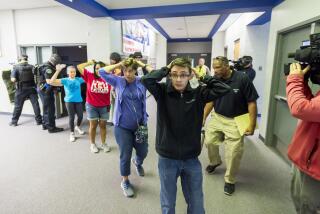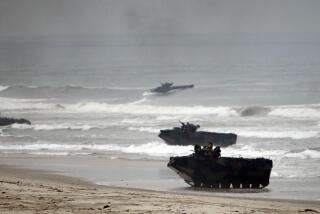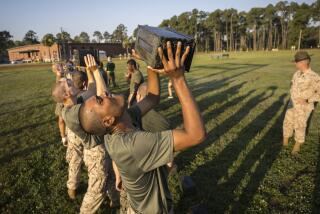Marines Step Into Simulated Combat
- Share via
CAMP PENDLETON — The combat may be simulated but the high-stress demand for decisive action amid confusion, complexity and danger is real.
For the first time, the Marine Corps is using computer-assisted simulations and clips from television news coverage of war-torn Bosnia and the movie “Full Metal Jacket” about Marines in Vietnam to teach corporals and sergeants how to exert leadership in combat.
Simulators have been used for years for aviators, tank crewmen and marksmanship courses, but the Combat Decisionmaking Range now being used here marks the technology’s debut as a teaching tool for infantry squad leaders, the backbone of the Marine Corps.
“This will never take the place of live-fire training or going out in the hills and getting dirty,” said James A. Lasswell, a retired Marine colonel now working for Gama Corp. of Falls Church, Va., which developed the course. “But maybe it will make squad leaders better prepared when they do go out to the real world.”
Soon all eight active-duty Marine Corps regiments will receive the CD-ROMs and instruction manuals needed for the course. Marine units assigned to amphibious assault ships will be able to sharpen their combat skills while afloat.
Army brass at Fort Benning, Ga., where the Army’s infantry training is centered, are studying the course.
In March, Marines from the 1st Battalion, 5th Regiment--the first Marines to undergo the simulation training--will join other Marines in an urban-warfare exercise in Northern California as a kind of final examination.
Modeled after computerized training developed by the New York Fire Department for new battalion chiefs, the course has aspects of the military computer games that have flooded the civilian market. The goal, however, is not fun, but experience.
“We hope that if these Marines ever get into a combat situation, they will have seen something like it before and know how to react,” said Capt. Mark Sullo, the former mathematics teacher who is the combat squad leaders’ project officer.
The exercise begins with a budding squad leader standing at a lectern in front of a movie screen in a darkened room.
A squad is comprised of 13 Marines: three four-man rifle teams and a squad leader. It is a truism in the Marine Corps that if squad leaders fail or freeze or blunder, all the paper-smart planning by rear-echelon officers is worthless.
During the exercise, two officers in the room play the role of fire team leaders who need orders from the squad leader.
Another officer plays the role of the company commander who needs information from the squad leader on the location of his fire teams, what obstacles they have encountered and how they plan to overcome them.
The video rolls and soon the squad leader confronts the realistic dilemmas that could be expected in a modern Third World brush fire conflict where civilians are caught in the cross-fire and the adversary prefers ambush.
“Avoid civilian casualties,” the captain on the video intones. “Remember, we’re here to help these people.”
Refugees rush toward the Marines, pleading for water. A mob turns ugly and begins to push and shove and claw at the Marines. Looting breaks out. A CNN crew shows up. Sniper fire pelts the ground.
A Marine is hit. The squad leader has to decide whether to attempt a rescue. Does he dare call for a helicopter evacuation when there is no secure landing zone? Does he call for an air strike when he’s unsure of the origin of the enemy fire?
Depending on the squad leader’s decisions, a computer technician puts different graphics up on the screen to symbolize returned fire, tear gas, smoke bombs, casualties and more. Movements are plotted on a map.
Within a half-hour, a squad leader is forced to make 30 or more life-and-death decisions.
An initial review after the training began in July found “a large variability in decision-making skills.” One area of concern was map-reading, with some squad leaders taking their squads hundreds of meters off course.
The goal of the exercise and other training is for squad leaders to learn how to both give and take orders, how to deal with immediate situations but not lose sight of the overall mission.
A common mistake for squad leaders is to attempt an immediate rescue of the fallen Marine with the result that another Marine is shot--a scene straight from “Full Metal Jacket,” complete with sound effects.
“I’ve seen that movie over and over, and I still fell into the trap,” said Cpl. Rodrick Bostick.
“It definitely made me think,” said Lance Cpl. Shane Wathen. “I went blank a few times.”
After the session, the squad leader’s performance is critiqued. The critique touches on the sensitive issues that arise when the mission is half military, half humanitarian, and the media is watching.
The Marines undergo three sessions of combat simulation during a 12-day rigor of book work, lectures and field training. The video scenarios became more more dicey, more hazardous.
Some of the scenes were filmed in the woods near Marine Corps headquarters in Quantico, Va. Others are from news clips. Additional scenarios are being developed.
“This is as realistic as we can get without putting rounds downrange and being in the action,” said Cpl. Leslie Howard. “I’m not much good at words, but I know this is good-to-go.”
More to Read
Sign up for Essential California
The most important California stories and recommendations in your inbox every morning.
You may occasionally receive promotional content from the Los Angeles Times.










